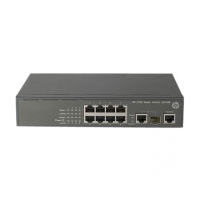217
Figure 57 NEXT_HOP attribute configuration
If a BGP router has two peers on a broadcast network, it does not set itself as the next hop for routes sent
to an EBGP peer by default. As shown in Figure 58, R
outer A and Router B establish an EBGP neighbor
relationship, and Router B and Router C establish an IBGP neighbor relationship. They are on the same
b ro a d c a s t n e t w o r k 1.1.1. 0 / 24 . W h e n Ro u t e r B s e n d s E B G P routes to Router A, it does not set itself as the
next hop by default. However, you can configure Router B to set it (1.1.1.2/24) as the next hop for routes
sent to Router A by using the peer next-hop-local command as needed.
Figure 58 NEXT_HOP attribute configuration
IMPORTANT:
If you have configured BGP load balancing, the router sets itself as the next hop for routes sent to an IBGP
peer or peer group regardless of whether the peer next-hop-local command is configured.
To configure the NEXT_HOP attribute (IPv4):
Ste
Command
Remarks
1. Enter system view.
system-view N/A
2. Enter BGP view or BGP-VPN
instance view.
• Enter BGP view:
bgp as-number
• Enter BGP-VPN instance view:
a. bgp as-number
b. ip vpn-instance
vpn-instance-name
N/A
3. Enter BGP IPv4 unicast
address family view or
BGP-VPN IPv4 unicast
address family view.
address-family ipv4 [ unicast ] N/A
4. Specify the router as the next
hop for routes sent to a peer
or peer group.
peer { group-name | ip-address }
next-hop-local
By default, the router sets itself as
the next hop for routes sent to an
EBGP peer or peer group, but does
not set itself as the next hop for
routes sent to an IBGP peer or peer
group.

